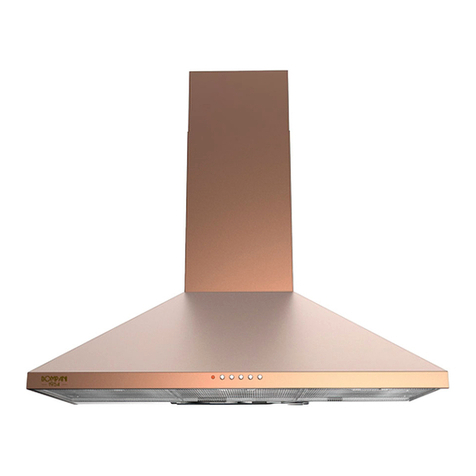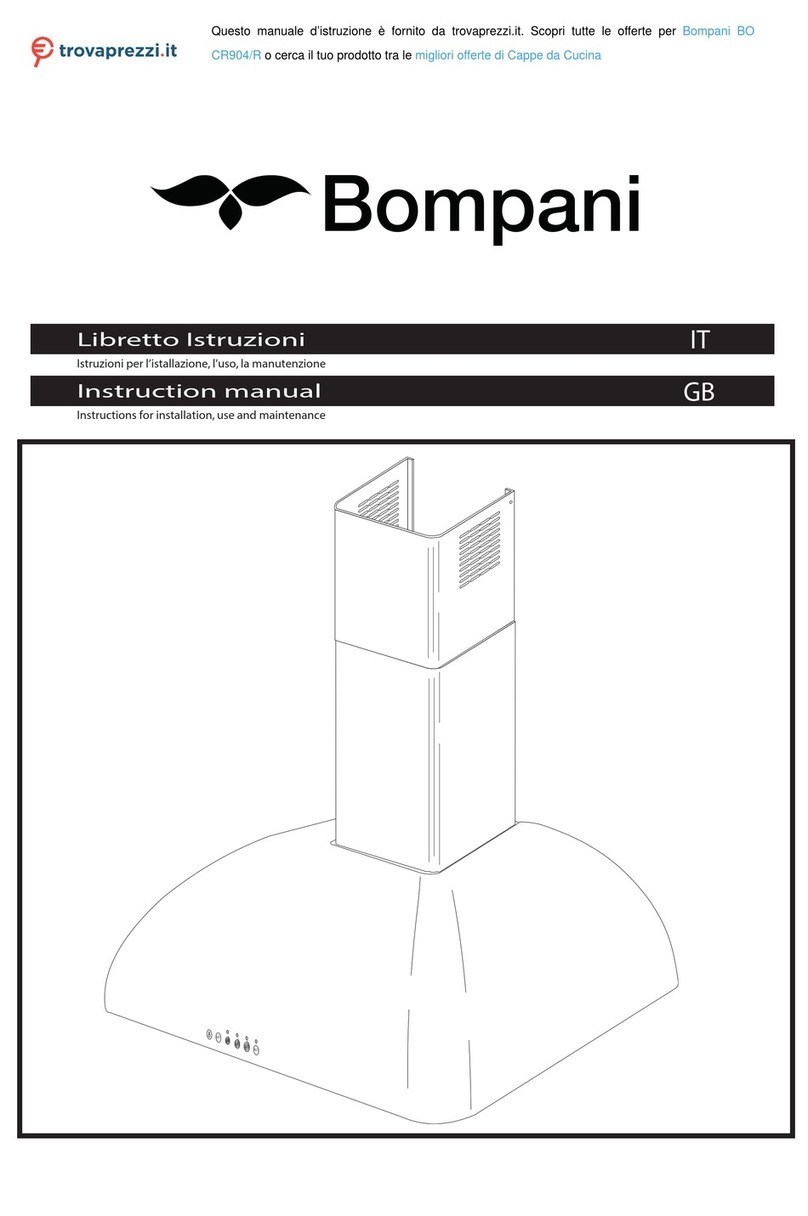
IT
4
A+A02
REGOLAZIONE DELLA VELOCITÀ DI ASPIRAZIONE
MANUALE
La scheda elettronica permette di regolare in maniera
manuale 3 diverse velocità di aspirazione per la cappa.
Per regolare l’aspirazione alla velocità 1 toccare breve-
mente il tasto con il simbolo relativo nello stesso istante l’emettitore
sonoro emette un beep, il led 1 si accende (mentre i led 2, led 3 se accesi
si spengono) e la velocità di aspirazione passa a 1 (velocità minima).
Per regolare l’aspirazione alla velocità 2 toccare brevemente il tasto con
il simbolo relativo nello stesso istante l’emettitore sonoro emette un
beep, i led 1 e led 2 si accendono (mentre il led 3 se acceso si spegne)
e la velocità di aspirazione passa a 2 (velocità media).
Per regolare l’aspirazione alla velocità 3 toccare brevemente il tasto
con il simbolo relativo nello stesso istante l’emettitore sonoro emette
un beep, i led 1, led 2 e led 3 si accendono e la velocità di aspirazione
passa a 3 (velocità massima).
Per spegnere l’aspirazione toccare brevemente il tasto con il simbolo
relativo nello stesso istante l’emettitore sonoro emette un beep, tutti i
led si spengono e l’aspirazione si spegne.
REGOLAZIONE AUTOMATICA DELLA VELOCITÀ DI
ASPIRAZIONE IN BASE ALLA TEMPERATURA
La scheda elettronica permette di regolare in maniera
automatica 3 diverse velocità di aspirazione per la
cappa in base alla temperatura rilevata dalla sonda di
temperatura presente all’interno della cappa aspirante.
Per regolare in maniera automatica, in base alla temperatura, la velocità
di aspirazione, in stato di OFF dell’aspirazione, toccare brevemente il
tasto con il simbolo relativo nello stesso istante l’emettitore sonoro
emette un beep e il led 4 comincia a lampeggiare secondo la sequenza
2 lampeggi – pausa - 2 lampeggi - pausa.
Da questo istante la velocità di aspirazione viene automaticamente re-
golata dalla scheda elettronica in base alla temperatura percepita dalla
sonda collegata alla scheda secondo la seguente tabella:
1. Temperatura inferiore a 50C°: Aspirazione OFF;
2. Temperatura tra 50°C e 60°C: Velocità 1;
3. Temperatura tra 60°C e 70°C: Velocità 2;
Temperatura superiore a 70°C: Velocità 3.
Per disabilitare la regolazione automatica dell’aspirazione toccare breve-
mente il tasto con il simbolo relativo nello stesso istante l’emettitore so-
noro emette un beep, ed il led relativo finisce di lampeggiare e si spegne.
TIMER DI SPEGNIMENTO AUTOMATICO
La scheda elettronica permette di impostare un timer di
spegnimento automatico aspirazione o luci. Per attivare
il timer, toccare brevemente il tasto relativo quando
almeno una tra luci e velocità di aspirazione risultano
attivate, nello stesso istante l’emettitore sonoro emette un beep e il led
4 comincia a lampeggiare secondo la sequenza lampeggio – pausa –
lampeggio – pausa.
Da questo istante il timer si avvia e trascorsi 15 min. luci e aspirazione
si spengono.
Per disabilitare il timer di spegnimento automatico toccare brevemente
il tasto con il simbolo relativo nello stesso istante l’emettitore sonoro
emette un beep, ed il led relativo finisce di lampeggiare e si spegne.
ATTENZIONE! A causa della progressiva saturazione con
residui grassi, l’infiammabilità aumenta e il funzionamento
della cappa aspirante può essere pregiudicato.
ATTENZIONE! Pulendo tempestivamente i filtri metallici si
previene il pericolo d’incendio, che può essere causato da
un accumulo di calore durante la frittura o l’arrosto.
Non preparare alimenti flambè sotto la cappa di cucina.
PULIZIA DEI FILTRI METALLICI:
Il lavaggio può essere effettuato ogni tre mesi ed eseguito nella lavasto-
viglie. Nel lavaggio è possibile una lieve alterazione del colore. Quando
si lavano filtri metallici, pulire anche i depositi di grasso sulle pareti
accessibili della carcassa.
ATTENZIONE! Non lavare i filtri metallici molto sporchi
insieme alle stoviglie. Per il lavaggio a mano, fare am-
morbidire i filtri grassi per più ore in una soluzione di
lavaggio bollente. Poi spazzolare, sciacquare bene con
acqua pulita e fare sgocciolare.
SMONTAGGIO E MONTAGGIO DEI FILTRI METALLICI:
- Premere le maniglie dei filtri (fig. 7 pos. 1) poi sganciare ruotandoli
verso il basso (fig. 7 pos. 2) dopo di che toglierli;
- Pulire i filtri (vedi pulizia dei filtri metallici);
- Inserire di nuovo i filtri facendo le operazioni inverse.
PULIZIA FILTRO A CARBONE ATTIVO DOVE
PREVISTO:
Il lavaggio può essere effettuato ogni tre mesi ed eseguito nella lava-
stoviglie.
Nel lavaggio è possibile una lieve alterazione del colore.
ATTENZIONE! Per la pulizia ed il montaggio del filtro al
carbone attivo rivolgersi alla casa costruttrice.
PULIZIA:
La pulizia della cappa è necessaria per evitare un pericolo d’incendio e
per assicurarsi un funzionamento ottimale. Per pulire la cappa aspirante
usare un soluzione di acqua e detersivo ben calda, oppure detergente per
vetri delicato. Non rimuovere lo sporco secco aderente graffiandolo, ma
ammorbiditelo con un panno umido. Non usare prodotti abrasivi o spugne.
AVVERTENZA! Non usare alcool (spirito) sulle superfici di
plastica, si potrebbero formare zone opache.
ATTENZIONE! Arieggiare sufficientemente la cucina, non
usare fiamme libere.
Pulire i tasti di comando solo con una soluzione di acqua e detersivo
delicato e con panno morbido, umido.
Per i tasti di comando non usare un pulitore per acciaio inox.
SUPERFICI IN ACCIAIO INOX:
Usare detergente per acciaio inox delicato, non abrasivo. Pulire strofi-
nando solo nel senso della lucidature. Non pulire le superfici in acciaio
inox con spugne dure, ne con detergenti contenenti sabbia, soda, acido
o cloruro.
Fig 7





























